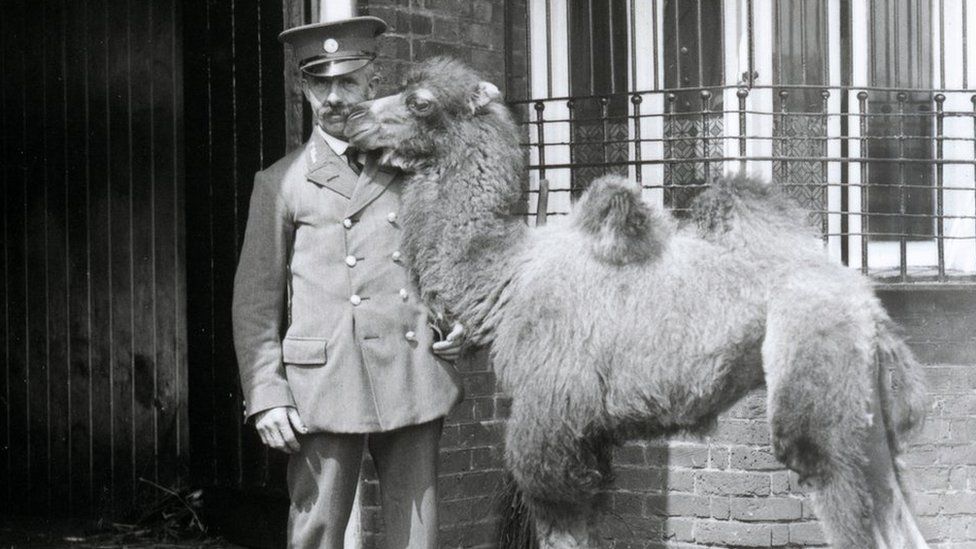London Zoo seeks memories and memorabilia to mark 200th anniversary
- Published

Zookeeper Wally Styles getting a kiss from a Bactrian camel in 1929
Memories and memorabilia are being sought by London Zoo to contribute to an exhibition marking its bicentenary.
Public submissions will be included in a 2026 display showcasing 200 years of conservation and research.
A 1930s ostrich egg, commemorative polar bear soaps and a first edition of Charles Darwin's On the Origin of Species, are artefacts already in the archive.
The zoo was the first to allow visitors without needing a special order.
The zoo's History Hive project, external aims to build a collection of "the tangible and the intangible", from vintage zoo toys and old tickets, to an oral history archive to preserve first-hand testimony.
Sir David Attenborough's very first natural history documentary, The Pattern of Animals, featured the zoo, and even Winnie the Pooh is based upon a black bear named Winnie, befriended by author A.A. Milne and his son Christopher Robin.
Natasha Wakely, the zoo's archivist, said the project was "an incredible opportunity for us to unearth the objects and material culture which bring to life our 200 years of history".
A commemorative soap to mark the arrival of baby polar bear Brumas
Old entrance tickets form part of the archive
The zoo, in London's Regents Park, had the first public fish house, insect house, reptile house, and built the first walk-through aviary. It also came up with the word aquarium, a portmanteau of aquatic and vivarium.
It was the first place to successfully breed a polar bear, called Brumas, in captivity and also has the only photographs of a living quagga - a zebra subspecies that is now extinct.
The only photographs of a living quagga were taken at the zoo
Brumas, pictured in 1949 with mother Ivy
The zoo has had a number of famous residents:
Guy the gorilla
Guy arrived in 1947, clutching a hot water bottle and only responding to French (having previously been in a Paris zoo)
Guy became one of the zoo's best loved characters - when sparrows entered his enclosure, he would scoop them up gently and peer at them before letting them go.
He died in 1978 from a heart attack while having surgery on his teeth.
Obaysch the hippo
An image from the 1870s shows the first hippo to reach Europe since the days of the Roman Empire
Obaysch was captured near an island in the Nile from which he took his name.
After wintering in Cairo he arrived in London on 25 May 1850, becoming the first hippo to reach Europe's shores since the days of the Roman Empire.
Queen Victoria inspected him shortly after his arrival and compared his swimming to that of a porpoise.
Goldie the golden eagle
Goldie the golden eagle escaped for almost a fortnight in 1965
When Goldie the golden eagle escaped in 1965, the story gripped the nation - even being mentioned in the House of Commons.
Five thousand people caused traffic jams around Regent's Park as he flew from tree to tree.
After 11 days and 19 and a half hours, he was finally recaptured and returned to the zoo.
Listen to the best of BBC Radio London on Sounds and follow BBC London on Facebook, external, X, external and Instagram, external. Send your story ideas to hello.bbclondon@bbc.co.uk
- Published21 January
- Published3 January
- Published29 July 2022